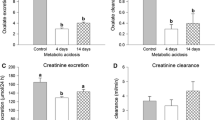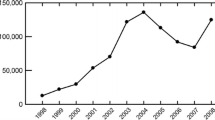Summary
Enteric hyperoxaluria and oxalate urolithiasis in patients with ileal resection seem to be caused by intestinal hyperabsorption of oxalate. The mechanism responsible for hyperabsorption of oxalate is not known. Intestinal transport of oxalic acid was therefore examined by an in vitro technique in rat intestine. Oxalic acid was absorbed by a mechanism of simple passive diffusion. The rate of absorption decreased from the colon to the duodenum (colon>ileum>jejunum>duodenum). Bile acids enhanced oxalic acid absorption in the large and small intestine and increased extracellular space; calcium, however, markedly decreased mucosal-serosal transport of oxalic acid. Cholestyramine known to reduce oxalate excretion in hyperuxaluria associated with ileal resection did not directly affect absorption of oxalic acid, but decreased the enhanced absorption of oxalic acid induced by bile acids. The results suggest that the beneficial therapeutic effect of cholestyramine in hyperuxaluria is rather mediated by its bile acid binding activity than by direct binding of oxalic acid.
Similar content being viewed by others
References
Admirand, W. H., Earnest, D. L., Williams, E.: Hyperoxaluria and bowel disease. Trans. Assoc. Am. Physicians84, 307–312 (1971)
Admirand, W. H.: The sources of excessive urinary oxalate excretion in patients with distal ileal disease. In: Bile Acids in Human Diseases, P. Back, W. Gerok, Eds., pp. 249–255. Stuttgart, New York: F. K. Schattauer 1972
Andersson, H.: Hyperoxaluria with ileal dysfunction (letter to editor). New Engl. J. Med.290, 107–108 (1974)
Andersson, H., Jagenburg, R.: Fat-reduced diet in the treatment of hyperoxaluria in patients with ileopathy. Gut15, 360–366 (1974)
Binder, H. J.: Intestinal oxalate absorption. Gastroenterology67, 441–446 (1974)
Caspary, W. F.: Analysis of the inhibitory effect of biguanides on glucose absorption: inhibition of active sugar transport. Diabetologia7, 379–385 (1971)
Caspary, W. F., Creutzfeldt, W.: Inhibition of amino acid transport by blood sugar lowering biguanides. Diabetologia9, 6–12 (1973)
Caspary, W. F.: Effect of biguanides on intestinal transport of sugars, amino acids, and calcium. Naunyn Schmiedeberg's Arch. Pharmacol.269, 421 (1971)
Caspary, W. F., Tönnissen, J.: Enterale Hyperoxalurie. I. Intestinale Oxalsäureresorption bei gastroenterologischen Erkrankungen. Klin. Wochenschr. (im Druck)
Caspary, W. F., Balfanz, A., Windemuth, H.: Mechanismus der Oxalsäureresorption im Dünn- und Dickdarm. 29th meeting Deutsche Ges. Verd. Stoffwechselerkr., Würzburg: Abstr. No. 19, 1974
Caspary, W. F., Creutzfeldt, W.: Inhibition of bile salt absorption by blood-sugar lowering biguanides. Diabetologia11, 113–118 (1975)
Caspary, W. F.: Die Beeinflussung der Resorptionsleistungen der Darmmukosa durch Pharmaka. Arzneimittelforschung25, 489–498 (1975)
Caspary, W. F.: Zum Wirkungsmechanismus von Cholestyramin bei enteraler Hyperoxalurie. 30th meeting Deutsche Ges. Verd. Stoffwechselerkr., Abstr. No. 36. Wien: Sept. 1975
Caspary, W. F.: Erworbene Hyperoxalurie und Nephrolithiasis bei gastroenterologischen Erkrankungen („enterale“ Hyperoxalurie). Deutsche Med. Wschr.100, 1509–1513 (19 )
Chadwick, V. S., Modha, K., Dowling, R. H.: Mechanism of hyperoxaluria in patients with ileal dysfunction. New Engl. J. Med.289, 172–176 (1973)
Chadwick, V. S., Modha, K., Dowling, R. H.: Mechanism of secondary hyperoxaluria in ileal resection. In: Bile Acids in Human Diseases, P. Back, W. Gerok, Eds., pp. 243–247. Stuttgart, New York: F. K. Schattauer 1972
Chadwick, V. S., Modha, K., Dowling, R. H.: Hyperoxaluria with ileal dysfunction. New Engl. J. Med.290, 108 (1974)
Chignell, C. F.: The effect of phenolphthalein and other purgative drugs on rat intestinal (Na+−K+) adenosine triphosphatase. Biochem. Pharmacol.17, 1207–1212 (1968)
Crane, R. K., Mandelstam, P.: The active transport of sugars by various preparations of hamster intestine. Biochim. Biophys. Acta45, 460–476 (1960)
Deeren, J. J., Porush, J. G., Levitt, M. F.: Nephrolithiasis as a complication of ulcerative colitis and regional enteritis. Ann. int. Med.56, 843–853 (1962)
Dowling, R. H., Rose, G. A., Sutor, D. J.: Hyperoxaluria and renal calculi in ileal disease. Lancet1, 1103–1106 (1971)
Earnest, D. L., Johnson, G., Williams, H. E., Admirand, W. H.: Hyperoxaluria in patients with ileal disease: an abnormality in dietary oxalate absorption. Gastroenterology66, 1114–1122 (1974)
Gelzayd, E. A., Breuer, R. I., Kirsner, J. B.: Nephrolitiasis in inflammatory bowel disease. Am. J. Dig. Dis.13, 1027–1034 (1968)
Hofmann, A. F., Thomas, P. J., Smith, L. H., McCall, J. T.: Pathogenesis of secondary hyperoxaluria in patients with ileal resection and diarrhea. Gastroenterology58, 960 (1970)
Hofmann, A. F., Tacker, M. M., Fromm, H., et al.: Acquired hyperoxaluria and intestinal disease: evidence that bile acid glycine is not a precursor of oxalate. Mayo Clin. Proc.48, 35–42 (1973)
Krag, E., Krag, B., Lenz, K.: A comparison of stable and3H-labelled polyethylene glycol 4000 as non-absorbable water phase marker in the human ileum and feces. Scand. J. Gastroent.10, 105–108 (1975)
Lukie, B. E., Westergaard, H., Dietschy, J. M.: Validation of a chamber that allows measurement of both tissue uptake rates and unstirred water layer thickness in the intestine under conditions of controlled stirring. Gastroenterology67, 652–661 (1974)
Lindahl, W. W., Bergen, J. A.: Nephrolithiasis complicating colitis after ileostomy: a report of six cases. J. Urol. (Baltimore)46, 183–189 (1941)
Maratka, Z., Nedbal, J.: Urolithiasis as a complication of surgical treatment of ulcerative colitis. Gut5, 142–147 (1964)
O'Leary, J. P., Thomas, W. C. Woodward, E. R.: Urinary tract stone after small bowel bypass for morbid obesity. Am. J. Surg.127, 142–147 (1974)
Rickets, W. E., Palmer, W. L.: Complications of chronic non-specific ulcerative colitis. Gastroenterology7, 55–60 (1946)
Ruge, W., Köhler, J., Fromm, H., et al.: Hyperoxalurie bei Darm- und Lebererkrankungen. Z. Gastroenterologie15, 45–55 (1977)
Smith, L. H., Hofmann, A. F., McCall, J. T.: Secondary hyperoxaluria in patients with ileal resection and oxalate nephrolithiasis. Clin. Res. (abstr.)18, 541 (1970)
Smith, L. H.: Hyperoxaluria with intestinal disease. New Engl. J. Med.287, 412 (1972)
Smith, L. H., Fromm, H., Hofmann, A. F.: Acquired hyperoxaluria, nephrolithiasis, and intestinal disease: description of a syndrome. New Engl. J. Med.286, 1371–1375 (1972)
Smith, L. H., Hofmann, A. F.: Acquired hyperoxaluria, urolithiasis and intestinal disease: a new digestive disorder? Gastroenterology66, 1257–1261 (1974)
Starnes, C. W., Welsh, J. D.: Intestinal sucrase-isomaltase deficiency and renal calculi. New Engl. J. Med.282, 1023–1024 (1970)
Stauffer, J. Q., Humphreys, M. H.: Hyperoxaluria with intestinal disease. New Engl. J. Med.287, 412 (1972)
Stauffer, J. Q., Humphreys, M. H., Weir, G. J.: Acquired hyperoxaluria with regional enteritis after ileal resection: role of dietary oxalate. Ann. int. Med.79, 383–391 (1973)
Stauffer, J. Q., Stewart, R. J., Bertrand, G.: Acquired hyperoxaluria: relationship to dietary calcium content and severity of steatorrhea. Gastroenterology66, 783 (1974)
Wilson, T. H., Wiseman, G.: The use of sacs of inverted small intestine for the study of the transference of substances from the mucosal to the serosal surface. J. Physiol. (London)123, 116–125 (1954)
Author information
Authors and Affiliations
Rights and permissions
About this article
Cite this article
Caspary, W.F. Intestinal oxalate absorption. Res. Exp. Med. 171, 13–24 (1977). https://doi.org/10.1007/BF01851584
Received:
Issue Date:
DOI: https://doi.org/10.1007/BF01851584




